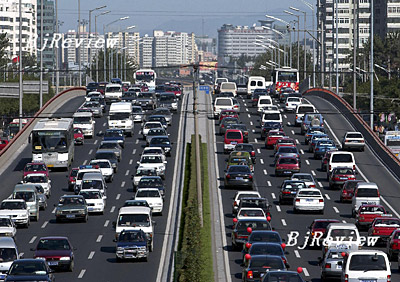
Outside the window is Erhuanlu (Second Ring Road), one of the busiest roads in Beijing. Zhang Wuchang, 68, sits in a chair on his balcony every day, listening to the radio and watching the automobiles go by. With his leg problem, Zhang is not able to move easily and is leading the life of a traffic voyeur. "It's been 10 years already, but I like sitting here because I can see my son driving to work and coming home," Zhang said.
For Zhang, the happiest part of the day is when his son picks up his grandson for school and passes by the building and his grandson waves to him from the car window.
Zhang also used to pick his own son up from school, but he rode a bicycle back then. "At that time, there were more bicycles than cars in Beijing," Zhang said. "But now, there are more cars than bicycles."
A 40-fold increase in 17 years
Zhang Yu, Zhang Wuchang's son, drives a Honda which he bought three years ago. It is Zhang Yu's second car. His first car was a Santana bought in 1993. Santana is one of the earliest brands produced by Volkswagen's joint venture in China, and still holds quite a large market share in the country today.
A former employee of the Beijing Environment Protection Bureau, Zhang Yu resigned to set up an advertisement company when he was 26 years old. Not long after China adopted the policy of reform and opening up, competition in the advertisement industry was not as fierce. Zhang Yu bought a car just two years later.
"At that time, buying a car made a stir, and many relatives came to see it and congratulate me," Zhang Yu said. "I felt like a real rich. But now, cars are so common that nobody would think it unusual to have one."
Since 2001, China has seen a rapid increase in the number of private cars on the road. Since China entered the WTO in December 2001, its auto market has become more open, driving the fast development of the domestic auto industry. With the increased number of models available, the prices have also lowered. Together with a series of government measures encouraging families to purchase cars, private cars are replacing service cars as the major sector of the car market here.
According to the National Bureau of Statistics, in 1990 there were only 5.54 million automobiles in China. Of the total, 820,000, or 14.8 percent, were owned by individuals. Among these, 580,000 were trucks and only 240,000 were passenger vehicles, and of these, many were mini-vans. The proportion of private cars was actually very small.
But by June this year, the number of private automobiles had topped 32 million, nearly 40 fold the number in 1990. Private automobiles now account for 60.48 percent of the country's total. Among private automobiles, more than 13 million were private cars, accounting for 76.14 percent of the total of private automobiles. At present, more than 100 million Chinese have obtained drivers licenses.
Two decades ago, people regarded automobiles as capital goods, and at the time nobody imagined they would become personal consumption goods. Now, more than 10 million households have their own cars.
A mobile life
Sometimes, Zhang Yu drives his father to the suburbs for an outing. In the spring, they drive to the open country to enjoy the beautiful flowers. In the summer, they go to mountain valleys. In fall, they go to suburban hills to enjoy autumn leaves. This makes Zhang Wuchang very happy as his life is extended from his home to the countryside.
"When I was young I could never imagine such life," he said. "At that time, we felt satisfied just riding to the riverside around home."
Driving to vacation has become part of the leisure lifestyle for many car owners. On weekends many drive to the countryside for a chance to relax in nature. Some of them even utilize the week-long May Day holiday or the National Day holiday to drive to other cities. Because of this, travel agencies have launched services for these driving vacationers. Websites have been created where people can post calls for driving and travel mates.
Qiandaohu Lake, meaning "thousand-island" lake, is a famous scenic area in Zhejiang Province, east China. During the May Day holiday week this year, driving travelers became the major force in this scenic area. Beginning from May 1, an average of 6,000 cars entered this area every day.
| 